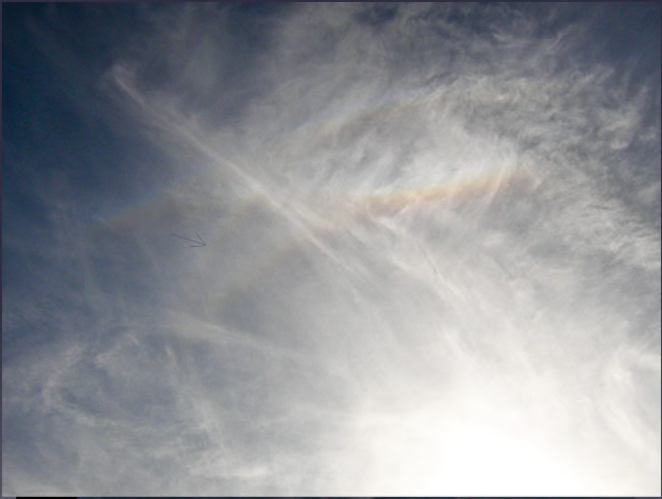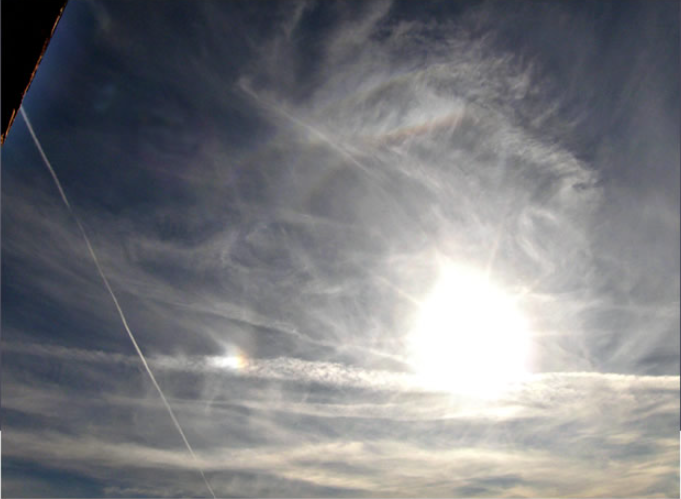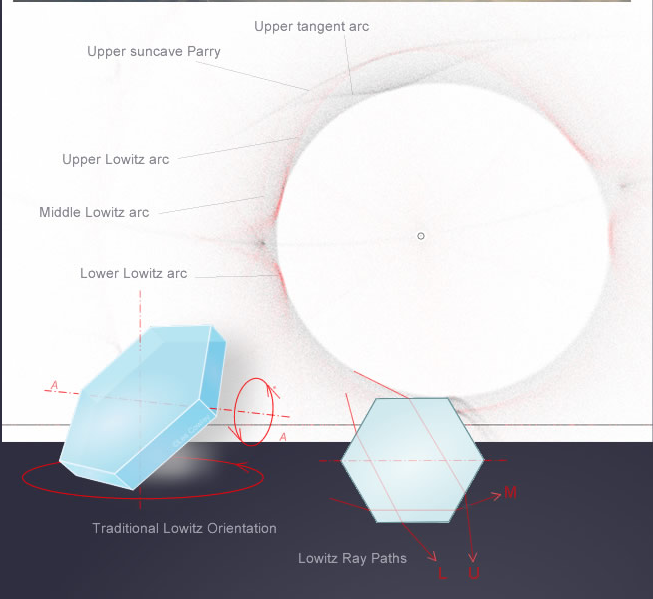Kievan rare Lowitz arc
The Enigmatic Kievan Rare Lowitz Arc
Atmospheric optics enthusiasts were treated to a rare spectacle in Kiev, Ukraine when the sky revealed the elusive Lowitz arcs. These arcs, which were once doubted by halo experts, have become a subject of fascination for dedicated observers. Although not observed frequently, they appear once in a while, leaving observers perplexed by their enigmatic nature.
The captivating image captured by Alexander Shynder showcases the Kievan cirrus and contrail ice crystal entangled sky. Taken at 14:03 local time with the sun positioned at approximately 25° high, the image reveals the distinct Lowitz arcs. These arcs have been labeled in the lower section of the image to provide a better understanding of their formation.
Among the more common atmospheric phenomena, such as the circular 22° halo and the upper tangent arc, there is another noteworthy display known as the suncave Parry arc. Positioned above the upper tangent arc, this unique feature adds an extra layer of complexity to the atmospheric optics scene.
One of the most intriguing aspects of the Lowitz arcs is the interaction between the upper Lowitz arc and the Parry arc. In this particular image, the upper Lowitz arc crosses the tangent arc and joins the Parry arc at its highest point. This interaction creates a mesmerizing visual effect that captivates observers and leaves them wondering about the underlying mechanisms at play.
As observers delve deeper into the images, they notice hints of additional Lowitz activity near the parhelion, with suggestions of a lower Lowitz arc and even a middle arc. However, due to the convoluted nature of the sky and the complex interplay of various atmospheric conditions, identifying these arcs becomes a challenging task.
To gain further insights into the behavior of Lowitz arcs, simulations utilizing traditionally oriented Lowitz plates have been conducted. These simulations reveal that near the parhelion at this solar altitude, expectations for Lowitz activity should be tempered. The lack of enhanced brightness on the 22-degree halo, specifically at the 10 o'clock position, caused by the strong upper Lowitz arc, poses an intriguing puzzle. Potential explanations include variable Lowitz crystal concentrations across the clouds or the possibility that the upper arc was formed by Lowitz columns rocking back and forth from a Parry orientation.
The simulation used for studying Lowitz arcs employed 64 grey levels and several million rays. It focused on monochromatic light, resulting in sharper arcs compared to those observed in the sun's white light. To match the image, HaloSim was modified to depict the Lowitz rays in red. This simulation highlights the intricate details of Lowitz arc formation and sheds light on their distinct characteristics.
One of the reasons behind the rarity of Lowitz arcs is their horribly inefficient production process. While the Parry arc requires only a sprinkling (2%) of crystals, the Lowitz arc demands 15 times that number. This stark difference in crystal concentration contributes to the infrequency of Lowitz arc sightings, making them even more special for those fortunate enough to witness them.
The Kievan rare Lowitz arc serves as a reminder of the boundless wonders present in our atmosphere. Despite their elusiveness and enigmatic nature, these arcs continue to captivate observers and fuel their curiosity. As dedicated enthusiasts and researchers delve deeper into the intricacies of atmospheric optics, they strive to unravel the mysteries surrounding these awe-inspiring natural phenomena.

Rare Lowitz Arc, Ukraine Imaged in Kiev by Alexander Shynder (blog) on Monday 28th September '09. ©Alexander Shynder, shown with permission.
The Kievan cirrus and contrail ice crystal entangled sky revealed Lowitz arcs from 14:00 to about15:00 local time. Not so many years ago halo experts even doubted their very existence. Nowadays, dedicated observers image them not exactly frequently but once every so often. Nonetheless, Lowits arcs still guard their enigmas.
The scene at left was taken at 14:03 with the sun ~25° high. The arcs are labeled in the lower (approximately) matching HaloSim ray tracing simulation. The Lowitz arc is also arrowed in the image.
The everyday halos are the 22° circular from poorly oriented crystals and an upper tangent arc from horizontal columns.
Worthy of note in any other display, there is a suncave Parry arc above the upper tangent arc.
The upper Lowitz arc crosses the tangent arc to join the Parry at its highest point.
There is little evidence in the images for Lowitz activity near the sundog here blazing in contrail ice. One or two pictures taken later on have hints of a lower Lowitz arc near the parhelion and even a middle arc. However, they are only suggestions and the convoluted sky renders identification difficult.
The simulation using traditionally oriented Lowitz plates tells us not to expect too much near the parhelion at this solar altitude.
The lack in the images of any enhanced brightness on the 22-degree halo at the 10 o'clock position produced by the strong upper Lowitz arc is less easy to explain away. We could invoke variable Lowitz crystal concentrations across the clouds. Another possibility is that the upper arc was produced not by traditionally oriented Lowitz crystals but by Lowitz columns rocking back and forth from a Parry orientation (Parry and Lowitz crystal orientations are related and the two sets of arcs are sometimes tangent to each other).
About the simulation: It used 64 grey levels and several million rays. It is for monochromatic light and hence arcs are much sharper than in the sun's white light. The circular 22° halo is distorted in the projection used to match the image. HaloSim was modified to show the Lowitz rays in red.
Lowitz arc production is horribly inefficient (one reason for their rarity) - the Parry arc needed only a sprinkling (2%) of crystals. The Lowitz needed 15X that number!


Note: this article has been automatically converted from the old site and may not appear as intended. You can find the original article here.
Reference Atmospheric Optics
If you use any of the definitions, information, or data presented on Atmospheric Optics, please copy the link or reference below to properly credit us as the reference source. Thank you!
-
<a href="https://atoptics.co.uk/blog/kievan-rare-lowitz-arc/">Kievan rare Lowitz arc</a>
-
"Kievan rare Lowitz arc". Atmospheric Optics. Accessed on November 26, 2024. https://atoptics.co.uk/blog/kievan-rare-lowitz-arc/.
-
"Kievan rare Lowitz arc". Atmospheric Optics, https://atoptics.co.uk/blog/kievan-rare-lowitz-arc/. Accessed 26 November, 2024
-
Kievan rare Lowitz arc. Atmospheric Optics. Retrieved from https://atoptics.co.uk/blog/kievan-rare-lowitz-arc/.